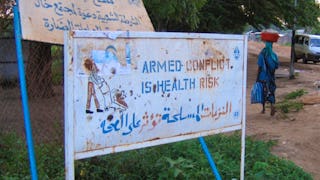NCDs are the leading cause of death in almost every region of the world, and place a huge burden on individuals, families and societies. Humanitarian settings have a negative effect on the levels of disease, and the possibility of treatment. The importance of NCDs in global health is acknowledged by their inclusion in the Sustainable Development Goals, which call for a reduction of a third in premature mortality from NCDs by 2030. However, NCDs have until recently received little attention in humanitarian settings, leaving prevention, care and treatment needs largely unaddressed among some of the most vulnerable populations. According to the World Health Organization, 70 percent of global deaths are due to NCDs. The four main disease groups which cause the greatest number of deaths are cardiovascular disease, cancer, diabetes and chronic obstructive pulmonary disease (including asthma).



Non-Communicable Diseases in Humanitarian Settings

Instructor: Siri Tellier
Access provided by The National Institute of Engineering
4,820 already enrolled
(118 reviews)
Skills you'll gain
Details to know

Add to your LinkedIn profile
9 assignments
See how employees at top companies are mastering in-demand skills

There are 3 modules in this course
In module one you will learn about why NCDs have increased in the world as a whole and about why NCDs are a particular problem in humanitarian emergencies or crises. Natural disasters and complex emergencies including armed conflict may have a negative effect, both on the levels of disease, and on the possibilities for preventing, treating or caring for people with NCDs.
What's included
6 videos7 readings3 assignments
In module two you will learn about some of the basic approaches of humanitarian action and how they might that apply to NCDs. This would include basic concepts, and how they might help or hamper the response to NCDs.
What's included
4 videos9 readings3 assignments
In module three you will learn about prioritization (the classical first priority for health response to save lives, and concentrate on excess mortality and morbidity), the importance of risk analysis (the risk equation), the challenges involved in transition from acute to longer term assistance – from blueprint to contextualizing and building capacity – as well as about longer term budgetary issues.
What's included
4 videos7 readings3 assignments
Instructor

Offered by
Why people choose Coursera for their career




Learner reviews
118 reviews
- 5 stars
80.50%
- 4 stars
18.64%
- 3 stars
0.84%
- 2 stars
0%
- 1 star
0%
Showing 3 of 118
Reviewed on Oct 17, 2019
This course is incredibly interesting and well structured
Reviewed on Jul 20, 2023
I loved the case studies and the articles to read.
Reviewed on May 18, 2021
So valuable course and great learning opportunity- really recommended and to review again for info refresh
Explore more from Health

Imperial College London

Emory University

University of Copenhagen

University of Manchester

